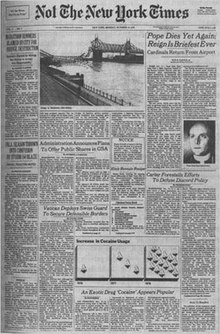
Not The New York Times was a parody newspaper of The New York Times created by Christopher Cerf, George Plimpton, Freddy Plimpton, Rusty Unger, and Tony Hendra, and published during the 1978 New York City newspaper strike.

Not The New York Times was a parody newspaper of The New York Times created by Christopher Cerf, George Plimpton, Freddy Plimpton, Rusty Unger, and Tony Hendra, and published during the 1978 New York City newspaper strike.
Due to a multi-union labor strike by pressmen that had halted production of The New York Times, the New York Daily News , and the New York Post , the Times had not been published since August 9, 1978. [1] [2] The strike had occurred due to the three newspapers each issuing new work rulings which significantly decreased requirements concerning the level of staffing. More than 10,000 workers had walked out during the strike. [2] On October 5, the Post resumed publication when Rupert Murdoch, its owner and publisher, had signed an agreement with the pressmen; however, the Daily News and the Times were still not being produced. [2]
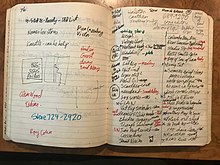
In September 1978, a plan to create Not The New York Times was developed by multiple writers. [3] The newspaper was co-created by Christopher Cerf, George Plimpton, Freddy Plimpton, Rusty Unger, and Tony Hendra. Cerf was a songwriter for Sesame Street , George Plimpton had co-founded The Paris Review , while Hendra was an editor at National Lampoon , and Unger was a columnist for The Village Voice . [3] [4] Unger had suggested the idea of a parody of The New York Times to Cerf, and Cerf told her that he had discussed the same project with Hendra. [3] Cerf had admired Victor Navasky's parodies of the New York Post and the New York Daily News, and Cerf, Hendra, and Unger decided to contact writers that they knew in order to help work on the newspaper. [3] The first person that Unger contacted was Veronica Geng, a writer for The New Yorker , who contributed to the paper. [3] Frances FitzGerald, a writer who worked on the project, recalled that Unger would call people and ask, "We don't know what we're doing exactly, but come help us." [3]
Cerf said that the "real fun" began when they discovered that staff who worked at the Times wanted to work on the parody as well. [3] Steven Crist, then a copy boy at the Times who had begun trying to make a living through betting on horse racing during the strike, joined the project. Crist would later become a horse racing writer for the Times. [3] [5] Richard Yeend, a designer at the Times, said, "I had no food at the time. I figured this might be an opportunity to have a free meal. I learned that was exactly what this was." [3] FitzGerald contacted Kevin Buckley, a Vietnam War correspondent for Newsweek , who joined the project as well. [4] Glenn Collins, an editor and reporter at the Times, also participated in the parody. [3]
Numerous other writers took part in the production of the newspaper. Carl Bernstein, a reporter known for his work on the Watergate scandal, and then-wife Nora Ephron, joined the project. [3] Collins called the writers a "genius gang of pranksters". [3] Other people who participated in the production included Michael Arlen, Jerzy Kosinski, and Terry Southern. [4]
The contents of the newspaper were written by different authors. Geng authored a seven-paragraph piece written entirely in bureaucratese titled "Carter Forestalls Efforts to Defuse Discord Policy", which was printed on the front page. [1] [3]
Not The New York Times was made up of 24 pages, and included 3 sections, 24 fake advertisements, 73 satire articles and 155 fake news briefs. [3] [6] The newspaper carried the slogan "All the News Not Fit to Print", as a parody of the Times' motto "All the News That's Fit to Print". [1] The names of its sections were parodies of the Times' content as well, with "The Having Section" parodying "The Living Section", and "SprotsMonday" [ sic ] parodying the Times' sports section, which on Mondays was titled "SportsMonday". [3] [7] The weather notice included the announcement "Mostly present today, still there tomorrow". [1]
The New York Times resumed publication along with the Daily News on November 6, 1978, after 88 days of non-production, a new record. The newspapers reached an agreement with the unions representing the pressmen. [8]
Jim Romenesko of Poynter praised the newspaper as the best parody of The New York Times. [9] Jim Dwyer stated that the parody set the modern standard for fake news, and called it a "pitch-perfect replica, spiritually and physically". [4]
Since the release of Not The New York Times, multiple parodies of the Times and other newspapers have been created. On April 1, 1982, a parody of The Wall Street Journal titled Off The Wall Street Journal, was released, with many of the same writers from Not The New York Times also participating, including Hendra. [10] On November 12, 2008, a spoof of the Times titled New York Times Special Edition was produced and distributed by the activist group The Yes Men. [4] [11] On May 5, 2011, a parody website of the Times, called "The Final Edition", was launched by Hendra, who facetiously thanked the Times for "being so ridiculously easy to parody". [12]
The newspaper is available in Columbia University's Seymour B. Durst Collection of Historical Manuscripts in the "Documents & Newspapers, 1764–1990" section. [13]

National Lampoon was an American humor magazine that ran from 1970 to 1998. The magazine started out as a spinoff from the Harvard Lampoon. National Lampoon magazine reached its height of popularity and critical acclaim during the 1970s, when it had a far-reaching effect on American humor and comedy. The magazine spawned films, radio, live theater, various sound recordings, and print products including books. Many members of the creative staff from the magazine went on to contribute creatively to successful media of all types.

The New York Times (NYT) is a daily newspaper based in New York City, with a worldwide reported readership of 9.41 million digital-only subscribers and 670,000 print subscribers as of 2023. Founded in 1851 as the New-York Daily Times, it is published by The New York Times Company. The Times has won 132 Pulitzer Prizes, the most of any newspaper, and has long been regarded as a national "newspaper of record". For print, it is ranked 17th in the world by circulation and 3rd in the United States. The newspaper is headquartered at The New York Times Building near Times Square, Manhattan.

The Onion is an American digital media company and newspaper organization that publishes satirical articles on international, national, and local news. The company is based in Chicago but originated as a weekly print publication on August 29, 1988, in Madison, Wisconsin. The Onion began publishing online in early 1996. In 2007, they began publishing satirical news audio and video online as the Onion News Network. In 2013, The Onion ceased publishing its print edition and launched Onion Labs, an advertising agency.

George Ames Plimpton was an American writer. He is widely known for his sports writing and for helping to found The Paris Review, as well as his patrician demeanor and accent. He was also known for "participatory journalism," including accounts of his active involvement in professional sporting events, acting in a Western, performing a comedy act at Caesars Palace in Las Vegas, and playing with the New York Philharmonic Orchestra and then recording the experience from the point of view of an amateur.

The New York Daily News, officially titled the Daily News, is an American newspaper based in Jersey City, New Jersey. It was founded in 1919 by Joseph Medill Patterson as the Illustrated Daily News. It was the first U.S. daily printed in tabloid format. It reached its peak circulation in 1947, at 2.4 million copies a day. As of 2019, it was the eleventh-highest circulated newspaper in the United States. Today's Daily News is not connected to the earlier New York Daily News, which shut down in 1906.

Michael O'Donoghue was an American writer and performer. He was known for his dark and destructive style of comedy and humor, and was a major contributor to National Lampoon magazine. He was the first head writer of Saturday Night Live and the first performer to deliver a line on the series.

The Harvard Lampoon is an undergraduate humor publication founded in 1876 by seven undergraduates at Harvard University in Cambridge, Massachusetts.
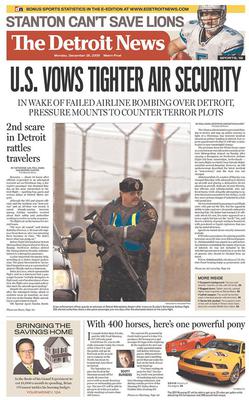
The Detroit News is one of the two major newspapers in the U.S. city of Detroit, Michigan. The paper began in 1873, when it rented space in the rival Detroit Free Press's building. The News absorbed the Detroit Tribune on February 1, 1919, the Detroit Journal on July 21, 1922, and on November 7, 1960, it bought and closed the faltering Detroit Times. However, it retained the Times' building, which it used as a printing plant until 1975, when a new facility opened in Sterling Heights. The Times building was demolished in 1978. The street in downtown Detroit where the Times building once stood is still called "Times Square." The Evening News Association, owner of The News, merged with Gannett in 1985.

The Paris Review is a quarterly English-language literary magazine established in Paris in 1953 by Harold L. Humes, Peter Matthiessen, and George Plimpton. In its first five years, The Paris Review published works by Jack Kerouac, Philip Larkin, V. S. Naipaul, Philip Roth, Terry Southern, Adrienne Rich, Italo Calvino, Samuel Beckett, Nadine Gordimer, Jean Genet, and Robert Bly.

Anthony Christopher Hendra was an English satirist and writer who worked mostly in the United States. He was probably best known for being the head writer and co-producer in 1984 of the first six shows of the long-running British satirical television series Spitting Image and for starring in the film This Is Spinal Tap as the band's manager Ian Faith.
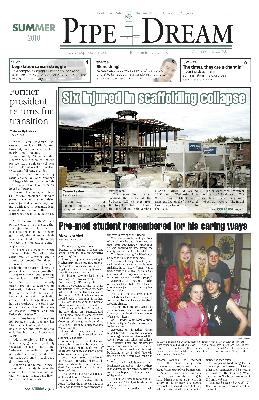
Pipe Dream is the student newspaper of Binghamton University in Vestal, N.Y. Content is published online throughout the week at bupipedream.com, as well as in print every Tuesday.

The Montreal Star was an English-language Canadian newspaper published in Montreal, Quebec, Canada. It closed in 1979 in the wake of an eight-month pressmen's strike.
Christopher Cerf is an American author, composer-lyricist, voice actor, and record and television producer. He has contributed music to Sesame Street, and co-created and co-produced the PBS literacy education television program Between the Lions.
The Medium a student newspaper in the United States. It is a student-run weekly satire and comedy publication at Rutgers University, the state university of New Jersey. Founded in 1970 as The Livingston Medium, it is the second largest newspaper in circulation at Rutgers University, after the official student newspaper, The Daily Targum. Referring to itself as the "Entertainment Weekly of Rutgers University", the more recent incarnations of The Medium focus on satirical and humorous articles based on current events, popular culture, and events on the Rutgers campuses. Since 1970, the newspaper has been headquartered on Livingston Campus.
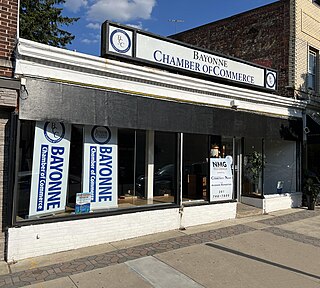
The Hudson Reporter was a newspaper chain based in Hudson County, New Jersey. The Hudson Reporter publications mainly focus on local politics and community news. The oldest newspaper in the chain was the Hoboken Reporter, founded in 1983. The chain closed on January 20, 2023.
Henry Nichols Beard is an American humorist, one of the founders of the magazine National Lampoon and the author of several best-selling books.

Radio Dinner is the debut album by the creators of the American satirical magazine National Lampoon. It was released on Blue Thumb Records in 1972 after RCA Records had declined to issue the record. The humor on the album is steeped in the pop culture and politics of the era. It includes "Deteriorata", a parody of Les Crane's hit rendition of the poem "Desiderata", and commentary on the 1972 presidential race. Among several pieces satirizing the former Beatles, "Magical Misery Tour" is a parody of John Lennon's primal therapy-inspired songwriting and his 1970 Rolling Stone interview, later published in book form as Lennon Remembers.

Roar News is the student newspaper of King's College London. It is editorially independent of both the university and the students' union.
The Missouri Lifestyle Journalism Awards were first awarded in 1960 as the Penney-Missouri Awards to recognize women's pages that covered topics other than society, club, and fashion news, and that also covered such topics as lifestyle and consumer affairs. The Penney-Missouri Awards were often described as the "Pulitzer Prize of feature writing". They were the only nationwide recognition specifically for women's page journalists, at a time when few women had other opportunities to write or edit for newspapers. The annual awards appear to have been last given in 2008.
The 1978 New York City newspaper strike ran from August 10 to November 5, 1978, a total of 88 days. It affected the New York City newspaper industry shutting down all three of the city's major newspapers: The New York Times, New York Daily News and the New York Post.